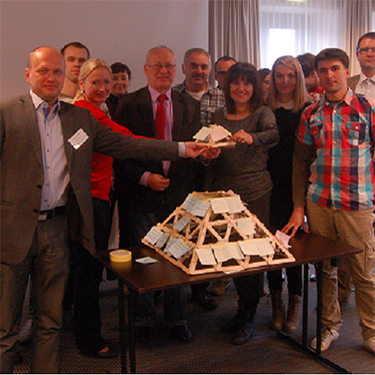
TARGET GROUP
Is participant experience relevant?It's okay if participants haven't seen the inside of a classroom in years. Physical trust needed
Mental trust needed
MATERIALSMaterial Description-flipchart
REQUIREMENTSDurationhalf day – week Experience level of the facilitatortaken part OR some facilitation experience Number of facilitators1-5 Location requirementsRoom with 5 tables, chairs, enough space. CHARACTER OF THE METHODLevel of activationactivatingWoo-Woo Level – How touchy-feely is this method?From 1.Rationalist-Materialist “No feelings here, folks.” to 5.Esoteric-Shamanic Bleeding Heart: Innovation Phases:• Method Category: |
SHORT DESCRIPTIONThe Pyramid Lite is a way to accelerate planning for sustainable development, guiding your group through discussion exercises, moving from information sharing to reflection and idea brainstorming, consensus building, and finally to goal setting and planning for action. ALTERNATIVE NAME OF THE METHODBuilding the Pyramid, Accelerator Lite BACKGROUNDBACKGROUND AND PURPOSE“Pyramid Lite” workshop is a tool available to everyone, free of charge, as a way to explore Sustainable Development Goals. You can get updated versions of Pyramid Lite — as part of a larger, free toolkit called “Accelerator Lite” — at this website: http://AtKisson.com/AcceleratorLite ORIGINAL SOURCEIn 1990, Alan AtKisson co-founded the Sustainable Seattle initiative, which would later be recognized by the United Nations as a model project in urban sustainability and indicator development. Sustainable Seattle would act as a catalyst for the meeting between key individuals and a shared purpose that would later give birth to the AtKisson Group. http://atkisson.com Link to a more complex method, of which this Method is part ofhttp://atkisson.com/visis/STEP-BY-STEP GUIDEPRE-EXERCISESPrepare a model of the pyramid: http://pyramid2030.net PREPARATION (excluding materials)The Pyramid Lite process starts with the choice of a “central challenge”, a global or local issue that you want to focus on. This could include topics related to climate change, poverty, access to safe drinking water, health care, education, or any significant problem, question, or issue that your group would like to explore. The Pyramid process then guides your group through discussion exercises, moving from information sharing, to reflection and idea brainstorming, to consensus building, and finally to goal setting and planning for action. By the end, your group will have explored the issue thoroughly, and developed a set of specific ideas for action. What you do with those ideas — and whether you turn them into real action — is up to you. http://atkisson.com/acceleratorlite/ 1 Central ChallengeChoose a Central Challenge for the workshop or you might want to have a conversation to choose a topic with your group. Is there a specific problem they are interested in exploring? 2 The Process - 5 Steps, 5 LevelsNote that the process has 5 steps, one for each level of the Pyramid: HARVESTTake a picture and celebrate! FURTHER INFORMATIONEXAMPLESA Pyramid Lite workshop can be run in just a few hours. You can even break it up into a few sessions — for example, if you are doing it as part of a classroom exercise, or across several lunch breaks at your place of work. CULTURAL VARIATIONSvariations of the materials http://atkisson.comTrainers for this method can be hired here:sendzimir.org.pl http://www.sendzimir.org.pl/en/contact-en |